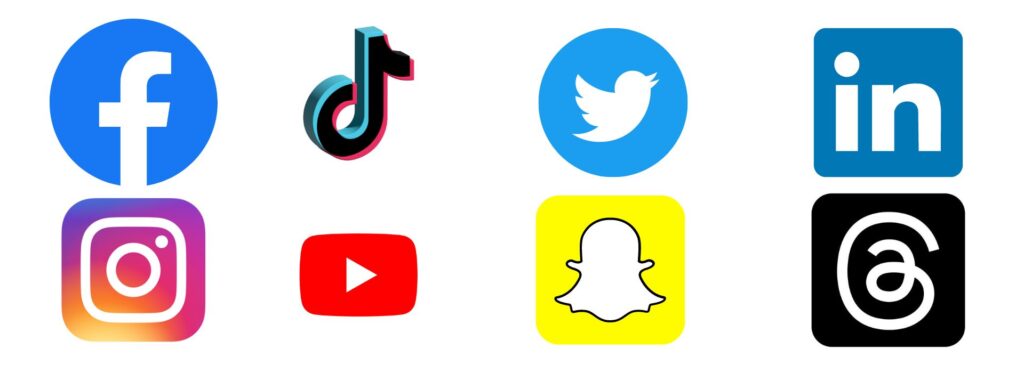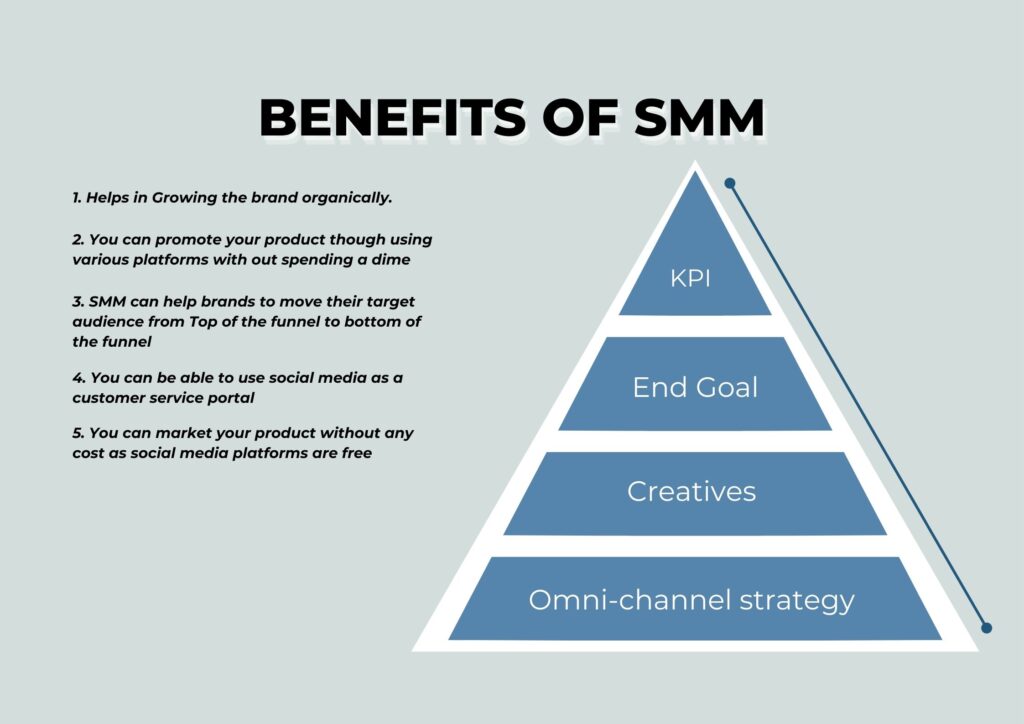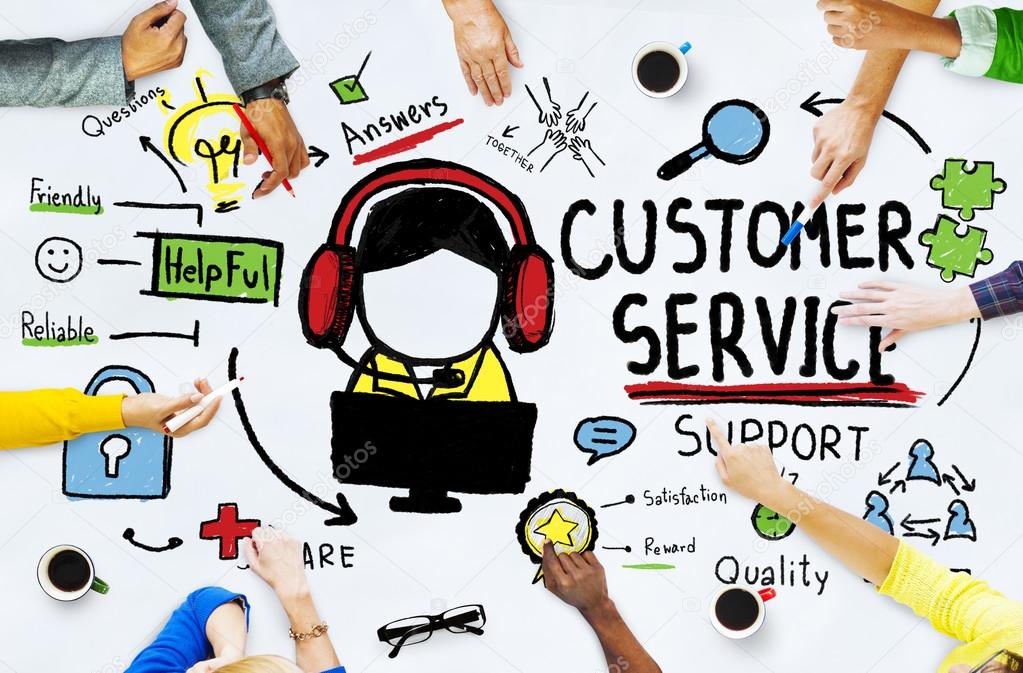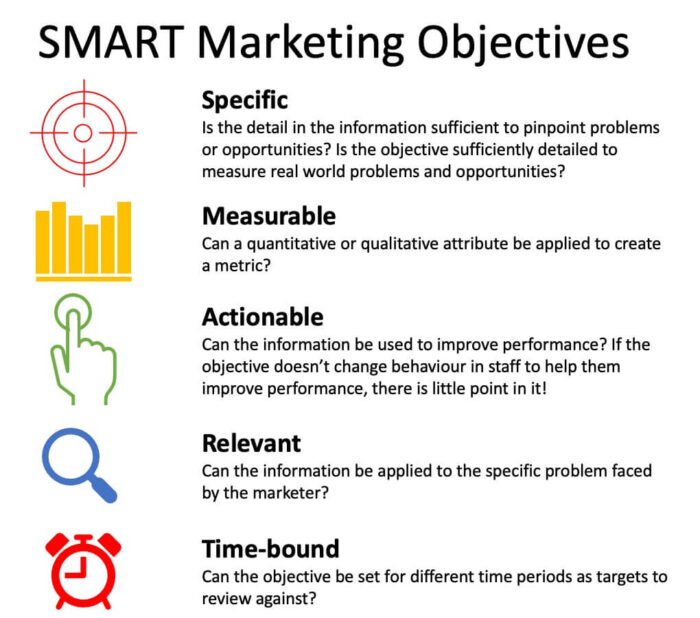How to Grow your business through Social Media Marketing(SMM)

Table of Content
- What is social media marketing?
- Important factors in social media
- Advantages of social media
- Social media marketing statistics
- Social media marketing plan
- Best social media marketing platforms
- Social media tools
- About Social media marketing services
What is social media marketing?
Social media marketing refers to utilizing social media platforms to promote products, services, or brands and engage with target audiences. It involves creating and sharing relevant and compelling content, participating in conversations with consumers / tg audiences, running advertising campaigns, and building relationships with followers and customers on platforms such as Facebook, Instagram, Twitter, LinkedIn, YouTube, and others. Through Social Media, Small businesses can grow rapidly by creating engaging content and interacting with consumers.
Social media marketing leverages the widespread use of social media platforms to reach and engage a large number of users, as these platforms provide opportunities for businesses to connect with their target audience in a more direct and interactive way. It allows businesses to build brand awareness, drive website traffic, generate leads, increase sales, and foster customer loyalty.
The success of social media marketing relies on factors like
- understanding the target audience,
- developing a strategic plan,
- creating engaging and shareable content, and
- utilizing the features and advertising options provided by different social media platforms.
By monitoring and analyzing performance metrics, businesses can optimize their social media marketing efforts and achieve their marketing objectives effectively.
It is important to note that the field of social media marketing is constantly evolving, with new platforms, features, and trends emerging regularly. Therefore, staying updated with the latest industry insights and adapting strategies accordingly is crucial for successful social media marketing campaigns.

2. Important factors in social media marketing
- Target Audience: Identifying and understanding your target audience is crucial for effective social media marketing. Conducting thorough market research helps you determine the demographics, interests, and preferences of your audience. This knowledge enables you to tailor your content and messaging to resonate with your target audience and engage them more effectively.
- Content Strategy: Developing a well-defined content strategy is essential for social media marketing success. Your content should be valuable, relevant, and engaging to attract and retain your audience’s attention. It is important to create a mix of different content types, such as informative articles, entertaining videos, captivating visuals, and interactive elements, to keep your social media presence diverse and appealing.
Great content strategy will include Types of content, Content format, medium/ platforms, the end goal, content scheduling, and many form factors.
- Consistency and Frequency: Consistency in posting and maintaining an active presence is vital in social media marketing. Regularly sharing high-quality content helps you stay visible, build credibility, and engage your audience. Establishing a content calendar and scheduling posts in advance can help maintain consistency. Additionally, monitoring engagement metrics and adjusting your posting frequency based on audience response is crucial to optimize your social media strategy.
- Engagement and Community Building: Social media is inherently social, and fostering engagement with your audience is key. Responding to comments, messages, and mentions promptly helps build relationships and customer loyalty. Encouraging conversations, asking questions, and running contests or polls can also boost engagement. Building a community around your brand by encouraging user-generated content and featuring customer stories can further enhance your social media marketing efforts.
- Analytics and Data-driven Decision Making: Monitoring and analyzing social media metrics is essential for measuring the effectiveness of your campaigns and making data-driven decisions. Platforms provide valuable insights into key metrics like reach, engagement, click-through rates, and conversions. By analyzing these metrics, you can identify trends, understand what content resonates with your audience, and optimize your strategy accordingly. Regularly reviewing analytics enables you to refine your approach and achieve better results over time.
By considering these important factors and adapting your social media marketing strategy accordingly, you can maximize the impact of your efforts, improve brand visibility, and drive meaningful engagement with your target audience.
3. Key advantages of Social media marketing:
- Increased Brand Awareness: Social media platforms provide a vast audience for businesses to showcase their brand. By consistently posting engaging content and interacting with users, businesses can significantly increase their brand visibility and reach. Social media allows for the sharing and amplification of content, enabling businesses to extend their reach beyond their immediate follower base.
- Targeted Advertising: Social media platforms offer robust advertising tools that allow businesses to target specific demographics, interests, and behaviors. This precise targeting capability ensures that your marketing messages reach the right audience, increasing the likelihood of generating leads and conversions. Targeted advertising also enables businesses to optimize their ad spend and achieve a higher return on investment (ROI).
- Enhanced Customer Engagement: Social media provides a direct and interactive channel for businesses to engage with their audience. Through comments, messages, and mentions, businesses can respond to customer inquiries, provide support, and address concerns promptly. This real-time engagement builds trust, fosters customer loyalty, and strengthens the relationship between the brand and its customers.
- Increased Website Traffic and Conversions: Social media marketing can drive significant traffic to your website or landing pages. By strategically including call-to-action buttons or links in your social media posts, businesses can direct users to their website to learn more, make purchases, or sign up for newsletters. By optimizing landing pages and using conversion tracking, businesses can measure and improve their conversion rates.
- Market Insights and Competitive Analysis: Social media platforms offer valuable insights into audience behavior, preferences, and trends. By monitoring analytics and tracking metrics, businesses can gain insights into what content performs best, understand audience sentiment, and identify emerging trends. Additionally, businesses can conduct competitive analysis by observing competitors’ social media presence, content strategies, and customer interactions, allowing them to refine their own marketing approach.
- Cost-Effective Marketing: Compared to traditional advertising channels, social media marketing is often more cost-effective. Creating social media accounts and posting organic content is generally free, while paid advertising options provide flexibility in budgeting and targeting. This affordability makes social media marketing accessible to businesses with limited marketing budgets, enabling them to compete with larger brands.
- Humanizing Your Brand: We often forget that customer loyalty and trust should be the first and last goals of a business. And nowadays, Inbound marketing is the key factor that changes the approach of businesses. Through social media you can share your behind the scene footage, and general awareness, you can chat with consumers to solve their queries, and by interacting with consumers, you present your brand in front of a large audience who are starting to trust your brand because of this human connection.
These benefits demonstrate the power of social media marketing in driving brand awareness, engagement, website traffic, and ultimately, business growth. However, it’s essential to develop a well-planned strategy, consistently monitor performance, and adapt based on audience feedback to maximize the benefits of social media marketing.

4. Social media marketing statistics
With regard to the benefits above, don’t just take our word for it. Let’s take a look at some social media marketing statistics that prove its power
- The average US adult spends 2.25 hours on social media every day.
- Over 70% of people who have a positive experience with a business on social media will recommend that business to their networks.
- Facebook users click on 12 Facebook ads on average every month.
- 81% of people use Instagram to research products and services.
- Nearly 80% of Twitter users feel more positive about a business when they get a response to their tweet.
- 4 out of 5 people on LinkedIn drive business decisions.
- 46% of TikTok users engage in the app without any other distractions.
5. Creating Social media marketing plan
Creating a detailed social media marketing plan is essential for a successful and organized approach to your social media efforts. Here are the key steps to developing a comprehensive social media marketing plan:
- Set Clear Goals: Start by defining your social media marketing goals. These goals should be specific, measurable, attainable, relevant, and time-bound (SMART). Examples of goals could include increasing brand awareness, driving website traffic, generating leads, or boosting sales. Clear goals will guide your strategy and help you measure success.
- Understand Your Target Audience: Conduct thorough research to identify and understand your target audience. Determine their demographics, interests, online behavior, and pain points. This information will help you tailor your content and messaging to resonate with your audience, ensuring maximum engagement and relevance. If you are targeting business professionals Linkedin may be a more prominent choice. Now there is Threads(by Meta) also. So Choose your platform based on the Target audience.
- Choose Relevant Social Media Platforms: Based on your target audience research, select the social media platforms that align with your audience’s preferences and behaviors. Focus on platforms where your target audience is most active. For example, if you’re targeting a younger demographic, platforms like Instagram or TikTok may be more effective.

- Develop a Content Strategy: Outline your content strategy, including the types of content you’ll create (e.g., articles, videos, images, reels, tweets, infographics), the tone of voice, and the themes or topics you’ll cover. Create a content calendar to plan and schedule your content in advance. Ensure your content provides value, is engaging, and aligns with your brand identity.
- Plan for Consistent Posting: Determine how often you’ll post on each social media platform. Consistency is crucial to maintain engagement and visibility. Decide on the optimal posting frequency for each platform, keeping in mind the preferences of your audience and the platform’s algorithms. Consider using social media management tools to schedule and automate your posts.
- Allocate Resources: Determine the resources needed to execute your social media marketing plan effectively. This includes budgeting for paid advertising, hiring social media managers or content creators, and investing in social media management tools or analytics platforms. Allocate resources based on your goals and the level of support required.
- Monitor and Measure Performance: Establish key performance indicators (KPIs) that align with your goals. These could include metrics like engagement rate, reach, click-through rate, conversions, or revenue generated. Use analytics tools provided by each social media platform, as well as third-party tools, to monitor and track your performance regularly. Analyze the data to gain insights into what’s working and what needs adjustment.
- Adjust and Optimize: Continuously evaluate your social media marketing efforts and make data-driven adjustments. Analyze audience feedback, engagement metrics, and trends to refine your content strategy, posting frequency, targeting, and messaging. Stay updated with social media trends and adapt your plan accordingly to stay ahead of the competition.
Remember that a social media marketing plan is not set in stone and should be flexible to accommodate changes in the social media landscape and your business objectives. Regularly review and update your plan to ensure it remains relevant and effective in achieving your goals.
6. Best social media marketing platforms
Determining the best social media marketing platforms depends on several factors, including your target audience, industry, goals, and resources. However, here are some of the popular social media platforms that offer significant marketing opportunities:
- Facebook: As of April 2023, Facebook has 1.908 billion daily active users (DAUs). This means that 65.9% of Facebook’s monthly active users (MAUs) log in on a mobile device or desktop each day. The number of daily active users on Facebook has been growing steadily over the past few years. In 2019, Facebook had 1.74 billion daily active users. In 2020, that number grew to 1.92 billion. And in 2021, it grew to 1.94 billion. Facebook remains one of the largest and most influential social media platforms. It provides robust advertising options, detailed audience targeting, and diverse content formats, including text posts, images, videos, and live streams. Facebook is suitable for a wide range of businesses and allows for building brand communities and engaging with customers.
- Instagram: As of July 2023, Instagram has 500 million daily active users (DAUs). This means that 1 in 8 people with mobile internet access uses Instagram at least once every 24 hours. Instagram is Known for its visual-centric nature, It is particularly popular among younger demographics and businesses in industries such as fashion, beauty, travel, and food. Instagram offers various advertising options, including photo ads, video ads, stories, and shoppable posts. Also because of reels anyone can promote their brand using various types of reels.

- Twitter: Twitter has around 353 million monthly active users and is well-suited for real-time updates, news, and engaging in conversations. It allows businesses to share concise messages, participate in trending discussions, and provide customer support. Twitter’s advertising options include promoted tweets, trends, and accounts, enabling businesses to amplify their reach and engagement. A lot of brands try to solve user’s queries through Twitter and participate in various conversations, which builds trust among consumers
- LinkedIn: LinkedIn is a professional networking platform with over 740 million users, making it valuable for B2B marketing and professional networking. It allows businesses to share industry insights, thought leadership content, and job postings. LinkedIn offers advertising options like sponsored content, text ads, and InMail for targeted B2B marketing campaigns.
- YouTube: As the second-largest search engine and a video-sharing platform with over 2 billion logged-in monthly users, YouTube offers vast marketing opportunities through video content. It is particularly effective for tutorial videos, product demonstrations, storytelling, and brand awareness campaigns. YouTube advertising options include pre-roll ads, display ads, and sponsored videos.
- TikTok: TikTok has gained immense popularity, especially among younger audiences, with over 700 million monthly active users. It is known for its short-form videos and creative content. TikTok offers advertising options such as in-feed ads, branded hashtag challenges, and branded effects to engage with users and increase brand visibility.
Other notable social media platforms worth considering depending on your target audience and industry include Pinterest, Snapchat, Reddit, Threads, and Twitch. It’s crucial to research and understand the demographics and user behavior of each platform to determine which aligns best with your marketing objectives.
Remember, it’s not necessary to be active on all platforms. Focus on the platforms where your target audience is most active, and where your content and brand messaging will resonate the most effectively. It’s better to have a strong presence on a select few platforms rather than spreading your efforts too thin across multiple platforms.
The thing to remember – Never put all your eggs into the same basket
7. Social media automation tools
Automation helps you in advance planning of your social media postings. If you plan your posts in advance, you will not miss important dates. Also, you can change any errors, as after automating your posts you can see previews.
Here are some automation tools which help in social media marketing and management
- Meta Business Suits- Meta Business suit is a free platform that helps you in managing your Facebook and Instagram pages, allows you to schedule your posts in advance and you can track your social media analytics through this platform. It has some flaws but if you want a free platform, Meta business suite is the best for sure.
- Buffer. Buffer is a popular social media management tool that allows you to schedule posts on Twitter, Facebook, LinkedIn, Instagram, and Pinterest. The free plan allows you to schedule up to 10 posts per social media account per month.
- Later. Later is another popular social media management tool that focuses on Instagram and Pinterest. The free plan allows you to schedule up to 30 posts per month and access analytics.
- Crowdfire. Crowdfire is a social media management tool that allows you to schedule posts, track your analytics, and find new followers. The free plan allows you to connect up to 10 social media accounts and schedule up to 100 posts per month.
- SocialOomph. SocialOomph is a social media management tool that allows you to schedule posts, track your analytics, and manage your social media inbox. The free plan allows you to connect up to 2 social media accounts and schedule up to 10 posts per day.
- Tailwind. Tailwind is a social media management tool that focuses on Pinterest. The free plan allows you to schedule up to 30 Pins per month and access analytics.
- Zoho Social. Zoho Social is a social media management tool that allows you to schedule posts, track your analytics, and manage your social media inbox. The free plan allows you to connect up to 3 social media accounts and schedule up to 5 posts per day.
- Combin. Combin is a social media automation tool that allows you to automate tasks such as following, unfollowing, liking, and commenting. The free plan allows you to use up to 100 credits per day.
- Friends+Me. Friends+Me is a social media management tool that allows you to schedule posts, track your analytics, and manage your social media inbox. The free plan allows you to connect up to 3 social media accounts and schedule up to 10 posts per day.
- TweetDeck. TweetDeck is a social media management tool that allows you to manage multiple Twitter accounts in one place. The free plan allows you to connect up to 2 accounts and schedule up to 30 Tweets per day.
- Hootsuite. Hootsuite is a popular social media management tool that allows you to schedule posts, track your analytics, and manage your social media inbox. The free plan allows you to connect up to 3 social media accounts and schedule up to 30 posts per day.
It is important to note that these are just a few of the many free social media automation tools available. When choosing a tool, it is important to consider your needs and budget. Some factors to consider include the number of social media accounts you want to connect, the number of posts you want to schedule, and the features you need.
Here are some additional tips for automating your social media postings:
- Plan your content in advance. This will help you save time and ensure that you are always posting fresh content.
- Use a variety of content formats. This will keep your followers engaged and interested.
- Optimize your posts for the best times to post. This will help you get the most views and engagement.
- Track your results. This will help you see what is working and what is not.
Automating your social media postings can be a great way to save time and keep your social media accounts active. By using one of the free tools listed above, you can easily schedule posts and track your results.
8. About Social media marketing service
Social media marketing services refer to the professional assistance provided by agencies or experts to businesses in planning, executing, and managing their social media marketing strategies. These services can range from consultancy and strategy development to content creation, advertising campaign management, community management, and performance analysis. Here are some key aspects of social media marketing services:
- Strategy Development: Social media marketing services begin with developing a comprehensive strategy tailored to the specific goals, target audience, and industry of the business. This includes defining objectives, selecting the appropriate social media platforms, determining content themes and formats, and outlining a content calendar.
- Content Creation: Social media marketing services often involve content creation, including writing compelling copy, designing graphics or visuals, and producing videos or other multimedia content. This ensures that businesses have engaging and shareable content that resonates with their target audience and aligns with their brand identity.
- Advertising Campaign Management: Many social media marketing services include managing advertising campaigns on various platforms. This involves setting up ad accounts, targeting specific demographics, creating ad content, optimizing campaigns for maximum reach and engagement, and monitoring performance metrics. Advertisements can be in the form of sponsored posts, display ads, video ads, or influencer collaborations.
- Community Management: Effective social media marketing involves actively engaging with followers and customers. Social media marketing services often include community management, which involves responding to comments, messages, and mentions in a timely and professional manner. This helps build relationships, provide customer support, and maintain a positive brand image.
- Performance Analysis and Reporting: Social media marketing services typically involve monitoring and analyzing performance metrics to evaluate the effectiveness of campaigns. This includes tracking key performance indicators (KPIs) such as reach, engagement, click-through rates, conversions, and ROI. Regular reporting helps businesses understand the impact of their social media efforts and make data-driven decisions for optimization.
- Keeping Up with Trends and Updates: Social media platforms constantly evolve, introducing new features and algorithms. Social media marketing services stay updated with these changes, ensuring that businesses adapt their strategies to leverage the latest trends and maximize their reach and engagement on social media.
Engaging social media marketing services can be beneficial for businesses that lack the time, expertise, or resources to manage their social media presence effectively. By leveraging the knowledge and experience of professionals, businesses can optimize their social media marketing efforts, enhance brand visibility, engage with their target audience, and achieve their marketing goals more efficiently.
At Performancemetrix I try to tell your stories through creative social media marketing techniques like copywriting, content writing, script creation, short video content creation and paid social media advertising.
I would love to work with you to grow your business. See my social media marketing portfolio here.